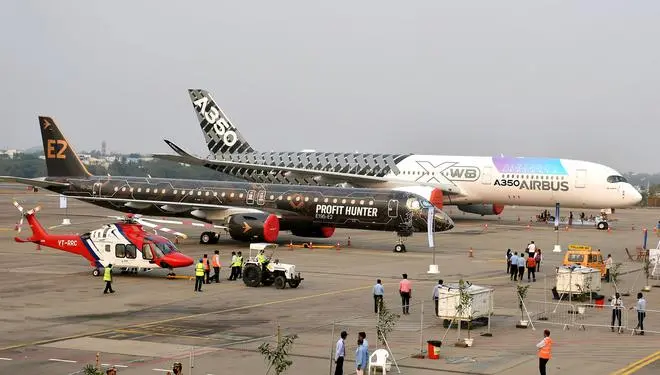The history of the Brazilian aeroplane maker, Embraer, in India has been tumultuous. Uneven ups and downs.
Some of the earliest commercial airlines in India to choose Embraer were Paramount Airways and Air Costa, both of which are now defunct.
Cheap tickets and the option of a window or aisle seat, Embraer's main selling point, were available on both carriers. Nonetheless, the airlines went out of business within few years because of issues with leasing companies. So happy was Air Costa with Embraer's performance, that it ordered 50 Embraer E-jets E2 worth $3 billion, but it had to be cancelled after the airline folded up.
Star Air, another regional airline, began service with Embraer ERJ145 aircraft two years after Air Costa ceased operations. With the recent decision to induct two more E175s to its fleet, Embraer might just be finding its feet again in the Indian market.
The plane maker’s top bosses are confident that it has a bright future, shedding a tentativeness that seemed to overshadow their earlier forays in India. “The country is adding new airports and expanding existing ones, providing greater access to Tier II and III cities. This presents opportunities to grow their fleet and enhance connectivity across the country.” Raul Villaron, Vice-President, Asia Pacific for Embraer Commercial Aviation, told BusinessLine.
The ATR challenge
Comparing Embraer's jets against ATRs, the regional turboprops from the family of a joint venture between two European aeronautical heavyweights, Airbus and Leonardo, was one of the most significant challenges confronting the company in India. ATRs could make a difference in the Indian aviation market due in part to the company's commitment to establishing an assembly operation in India if more turboprops were bought. Moreover, with a connection to Airbus, it was easier to persuade the airlines to combine it with the popular A320s for regional routes, despite the criticism that one of its popular models, the ATR42, was not as economical on regional roads as was believed.
The turboprop solution?
Embraer has finally discovered a solution to this problem. It’s E-Jets E2 aircraft and planned introduction of a modern turboprop aircraft. “Designed for domestic and regional operations, the E-Jets E2 aircraft has a maximum flight time of six hours and specialises in establishing and expanding new routes. This makes the E2 an attractive platform for connecting metro to non-metro and between non-metro cities in India, which will be the key growth drivers in the coming years,” Villaron stated.
The projected debut of turboprop could alter the competitive landscape for Embraer. It is anticipated to deliver a jet-like experience with better passenger experience and a step ahead in sustainability; it would be the first aircraft designed from the beginning for 100 per cent SAF (Sustainable Aviation Fuel) operations. The turboprop would also provide the lowest solutions for fuel consumption, emissions, airport noise footprint, and trip and seat costs. Embraer is also seeking global strategic collaborations for the turboprop programme, including possible Indian partners, an opportunity that would be difficult to pass up.
“The largest market in India is the market for regional airlines, which Star Air uses well. Once Embraer's new turboprop model enters service, it will be quite popular. Embraer must focus on the regional jet market to connect cities in Tiers II and III. Their entry into the turboprop industry will be a welcome option to ATR and Q 400,” Arun Lohiya, Chief Operating Officer,CAD Ventures Pvt Ltd, said.
But critics claim that the turboprops could become extinct with the market maturing, turning first-time flyers into frequent flyers.

An Airbus A350 aircraft, Embraer largest commercial aircraft, the E195-E2 and VT-RRC helicopter models on the tarmac. | Photo Credit: NAGARA GOPAL
The road ahead
Yet, Embraer believes that it has a good chance of selling more of its aircraft in India. “Airlines exist to provide a service while also making a profit. Flight data research revealed that even before Covid, 50 per cent of domestic flights in India departed with only 90 to 150 passengers (aircrafts in India have an average of 180 seats); aircrafts are flying with many seats unoccupied. This continual imbalance between demand and capacity costs airlines money, eroding yields and, ultimately, profits. Regional jets, such as our E-Jets E2 family of aircraft, provide airlines with the flexibility to place the aircraft on strategically important routes where demand is currently thin,” pointed out Villaron.
Even though Embraer is banking on more connections between metro and non-metros to expand the market for its aircraft, it will be the first to admit that the situation is improving, and the forecast is positive, but placing new aircraft orders remains difficult while cash conservation restrictions remain in place. The Brazilian plane maker will need to work hard to sell its aircraft in a market considered as one of the world's most complex and difficult markets to sell regional jets.







Comments
Comments have to be in English, and in full sentences. They cannot be abusive or personal. Please abide by our community guidelines for posting your comments.
We have migrated to a new commenting platform. If you are already a registered user of TheHindu Businessline and logged in, you may continue to engage with our articles. If you do not have an account please register and login to post comments. Users can access their older comments by logging into their accounts on Vuukle.